Stones of the World: The Inspiring Stones of Italy
Peter J. Marcucci
Special Contributor
Hover over photos to read caption
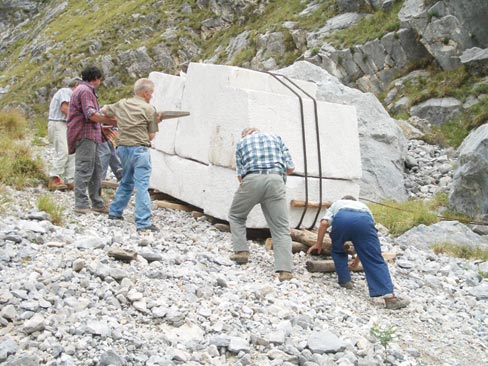 “I saw the angel in the marble and carved until I set him free” – Michelangelo Buonarroti
“I saw the angel in the marble and carved until I set him free” – Michelangelo Buonarroti
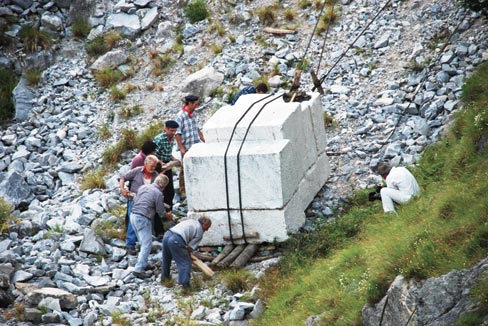 And like his predecessors – Donatello and Bernini – Michelangelo, during the making of his Angel, his David, and his Pieta, did so using the same Carrara marble utilized by the ever expanding Roman Empire to construct the many buildings, façades, bridges and aqueducts, since 9 BC. These vast deposits of white, quarried in the Apuan Alps, had not only been part of the calculus for the growth of Rome in the past, but, moreover, part of the success of the greatest sculptors who ever lived, leaving a legacy for a curious world and inspiring artists for centuries to come.
And like his predecessors – Donatello and Bernini – Michelangelo, during the making of his Angel, his David, and his Pieta, did so using the same Carrara marble utilized by the ever expanding Roman Empire to construct the many buildings, façades, bridges and aqueducts, since 9 BC. These vast deposits of white, quarried in the Apuan Alps, had not only been part of the calculus for the growth of Rome in the past, but, moreover, part of the success of the greatest sculptors who ever lived, leaving a legacy for a curious world and inspiring artists for centuries to come.
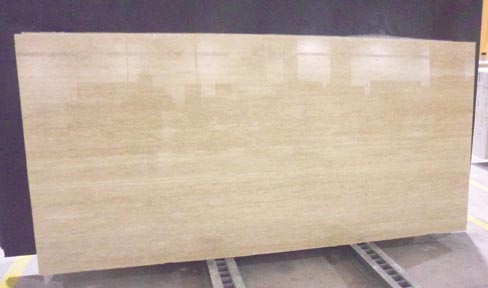 During Michelangelo’s late 16th and early 17th century life, the marble we know today as Carrara, Venatino and Statuary was still being quarried by the centuries-old methods of the ancient Romans by chiseling a row of holes and then inserting dry wood, which then was wetted and left to soak for days. As the wood slowly expanded, so did the stone, thereby splitting and creating a block, and when enough blocks were quarried, they were stacked onto a sled made of large wood timbers.
During Michelangelo’s late 16th and early 17th century life, the marble we know today as Carrara, Venatino and Statuary was still being quarried by the centuries-old methods of the ancient Romans by chiseling a row of holes and then inserting dry wood, which then was wetted and left to soak for days. As the wood slowly expanded, so did the stone, thereby splitting and creating a block, and when enough blocks were quarried, they were stacked onto a sled made of large wood timbers.
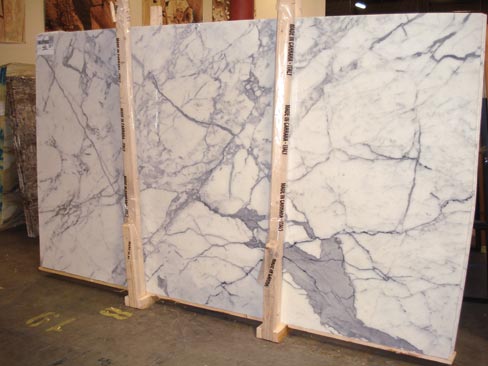 Once fully loaded, the blocks were lashed tight and the sled was incrementally lowered down the mountainside riding on a series of wood planks, while the men located higher up the mountain slowly released a series of ropes wrapped around strategically placed friction pylons for braking and steering.
Once fully loaded, the blocks were lashed tight and the sled was incrementally lowered down the mountainside riding on a series of wood planks, while the men located higher up the mountain slowly released a series of ropes wrapped around strategically placed friction pylons for braking and steering.
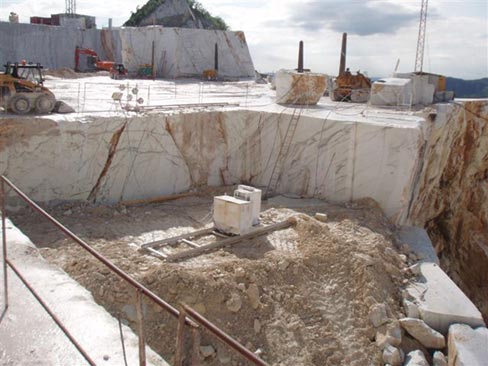 These men, known as “Lizzatori,” or sled men, would labor to the command of the capolizza (the foreman), and as the ropes loosened and the sled was steered, it continued its journey down the path of planks to the base of the mountain. Once at the bottom, the blocks were loaded onto wagons pulled by oxen and transported to the workshops or loading dock.
These men, known as “Lizzatori,” or sled men, would labor to the command of the capolizza (the foreman), and as the ropes loosened and the sled was steered, it continued its journey down the path of planks to the base of the mountain. Once at the bottom, the blocks were loaded onto wagons pulled by oxen and transported to the workshops or loading dock.
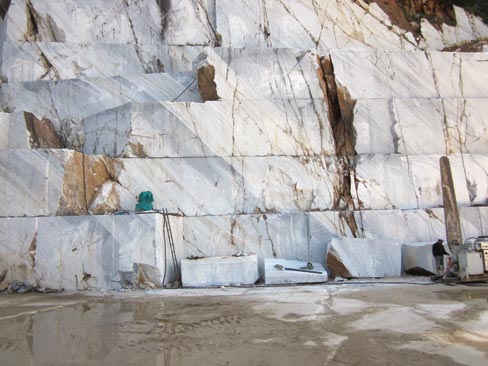 This ancient technique of timing and teamwork was known as “Lizzatura,” and although these sleds (commercially) are a thing of the past, a re-enactment known as “La Lizzatura” is still performed every year on the first Sunday of August for exhibition purposes and to commemorate the rich heritage of Carrara. Afterwards, food and wine are served to toast the day’s success.
This ancient technique of timing and teamwork was known as “Lizzatura,” and although these sleds (commercially) are a thing of the past, a re-enactment known as “La Lizzatura” is still performed every year on the first Sunday of August for exhibition purposes and to commemorate the rich heritage of Carrara. Afterwards, food and wine are served to toast the day’s success.
Those dangerous quarry methods of long ago have fallen by the wayside, but it really hasn’t been that long, explains Artist Daniel Sinclair, one of America’s foremost figurative and historic stone sculptors and owner of DMS Studios in Long Island City, New York.
“I’ve been doing sculpture for a number of years and was fortunate to have had a very archaic training, the history of which goes back many hundreds of years, so I was the lucky beneficiary of being at the right place at the right time.
“People were still using ox carts to move stone around when I began training in Pietrasanta, Italy in 1970, and that’s how stone was delivered to the shop where I worked. It was still common practice to use the primitive Roman techniques of quarrying back in those years, but all those things that I witnessed back then no longer exist today. That world is completely gone and not relevant anymore to the way Carrara stone is quarried, fabricated or carved,” said Sinclair, noting that there are several excellent white Italian marbles for sculpture and fabrication purposes.
“One considers white marble from Carrara of which there are various colors and grades, but what had been historically the most desirable marble is what was classified as Statuary. Statuary has a lot of subsets to it, and what qualifies it particularly good for sculptural purposes is its workability.
“Bianco-P, however, also from Pietrasanta, is a first class stone and is not classified as a Statuary, and as far as I know is still available. It has a bluish grayish cast and is extremely beautiful but doesn’t have a lot of depth to it and is not as luminescent as Statuary.”
Notably every province of Italy has a quarry of some type be it marble, slate, granite or limestone, with new deposits being discovered every year, but it’s the white marble of Carrara and Pietrasanta that remains legend according to Mike Bastone, Vice President of Sales at Walker-Zanger, an importer of the high-end, the exotic and the unusual.
“White marble has become the trend lately, and three of the most popular colors are in the white category with White Carrara being one of them. It’s clean, neutral, goes with anything and has a soft, easy look about it and has taken the market by storm. You see its use in magazine articles and kitchen books and it’s become very desirable. It is a design trend for sure.”
Mike went on to explain that other popular colors in today’s market are Venatino, Statuary and Calacatta as well as some grays. “In a White Carrara quarry for example, there is also Bardiglio Gray, a calcium carbonate-based marble that is becoming very popular. Designers and clients are using these grays for kitchens and kitchen islands. They will stain and etch, but the trend right now is to use these materials and just live with the consequences.
“Obviously granite is a better surface in terms of durability, but the aesthetic look of white or gray marble has become so popular right now that people are using it and sacrificing the durability for the look. It is the hottest trend that I have seen in my thirty plus years of doing this.” But be it fabricator or sculptor—it’s what’s in the mountains that gets you where you want to go—agreed Mike.
“There are several White Carrara quarries, but the most famous is a cave. If you go up the mountainside above Carrara, you can drive into a cave that is about 400 yards deep with several galleries inside, and that’s where there’s lot of the Carrara that is still being quarried.
“There are still many open quarries that are producing, but the cave quarry is the most exciting one to see because there is a gigantic hole in the ground that the blocks are brought out of. It’s a very expansive quarry, and seeing them pull the white marble out is very interesting. The blocks are then transported down the hill to whatever facility is buying the material.”
The majority of quarries, explained Mike, are typically open, and like most open quarries in Italy, blocks are quarried in the traditional sense where they make benches, and from those benches they cut and drop the large walls of stone that get cubed into blocks. “I don’t know how many quarries there are in Carrara, but there are many, many that are owned by different people.
“Some quarry owners have the saws and polishers to produce tiles and slabs, while other companies buy the blocks and produce. Most of the blocks are brought down to the town of Carrara, Marina di Carrara and Massa, with most sculpting being done in Pietrasanta. The whole region is littered with factories that are producing, but probably the most recognized company is Gemeg, which quarrys Statuary.”
The most quarried areas of Italy, according to Mike are between Carrara and Verona with the town of Tivoli being the most quarried for Travertine. “Travertine went through a huge surge in the late 90s, early 2000s and was almost like a buzz word in those days. ‘Do you carry Travertine?’ they’d ask. Some people didn’t even know what the word meant but would ask for it by name, so it gained a very strong brand recognition just by the name Travertine.
“I think it became a lower priced commodity item for sure when most of the Travertine coming into this country began coming from Turkey, so the travertine phenomenon of ten years ago has slowed down quite a bit. I do think that we are going to see a small uptick in the future though.
“I was just in Tivoli last June and there were some nice Travertines coming out of those quarries from the dark Noche walnut colors all the way to light Osso and Alabastrino. Also the re-emergence of vein-cut Travertine has become extremely popular lately, and has uplifted the popularity of the more expensive Travertines. People are seeking out that vein-cut look, so we are actually starting to buy more now.
“I’ve also seen some real nice versions of Roman Travertine, also referred to as AR-Travertine, which is a beige tone. I don’t think Travertine sales will come back to the point it was in the early 2000s, but there is a good and growing market for it.”
Today, Italian quarries are state-of-the-art operations that use super efficient and environment friendly extraction techniques. Carrara being the nucleus of Italy, abounds with sculpture and fabrication shops, and buildings full of gang saws and production lines. Marina di Carrara is a constituent of that nucleus featuring yards, cranes and trucks, and where most inbound blocks from other countries such as Brazil arrive to be cut and processed.
Most outbound stone commerce, including Italy’s, leave from Livorno. Livorno is Italy’s main portal to the world, where cargo ships wait silently ready to receive the many containers packed with slabs, blocks, and tile, bound for countries beyond the sea. Notably, La Spenzia, just to the north of Carrara, is also a major outbound port.
“When I began traveling in the 1980s, Carrara and Verona were really the two cities that you could find pretty much anything from around the world,” explains Mike, “but now there’s more direct buying in places like Brazil and Turkey. Many of these countries have very sophisticated equipment and don’t have to deal with the transportation issues of bringing their materials to Italy. That said, white marble has taken over the majority of the production in Carrara, but we can still find other nice materials there from other parts of the world.”
Just for the record, Brazil is unquestionably the world leader in combined granite and marble imports to the U.S., and although pressured by sales from huge marble producers such as Turkey, Mexico, Lebanon and China, Italy continues to hold a major market share in marble sales in the U.S.—even after a world recession.
“If you look at the production numbers before the recession and after the recession, Italy was clearly hurt. Many factories had sold off their equipment and production in the quarries was also significantly reduced. They all got hit very hard. I also think that the emergence of Turkey and China as big producers of stone also hurt Italy considerably, but again, the resurgence and demand for white marble really has boosted the area in terms of production. Carrara is still the hotbed.
“The pricing has risen too—I don’t know if I can say tenfold—but it has risen substantially based on the popularity and due to the difficulty of getting good quality. Some of these quarries are being quarried-out, but the demand for the quality has been rising.
“It’s not just the U.S. market that is shopping for white marble. There is a world demand for it especially in China, India and the Middle East, and when our people from Walker-Zanger are in these quarries, we are not just competing against competitors in the United States, we are competing against world demand for these marbles.
“So not only does it raise the price due to the demand, but also decreases the chance of getting good quality material. Fortunately, we’ve had an office in Italy for the 60 plus years that we’ve been in business, and it’s because of those long relationships that we’ve been able to keep getting good quality.”
Over the last few years production volume has rebounded, albeit slowly, and why shouldn’t it? Italy, as a whole, abounds with highly efficient quarries and has continued over the last seven years to produce quality premium, standard and commercial grade stones of all varieties. Also the new as well as older large-scale producers that had invested heavily in state-of-the-art production technology are now seeing the fruits of their labor bloom as marble sales continues to rebound.
Consider these figures for just a moment. The closing numbers for Italian marble imported to the U.S. from Italy in 2006 was just under 173 thousand tons compared to Brazil’s 5 thousand plus tons that same year. By 2009, well into our recession, Italy’s exports to the U.S. had dropped to 57 thousand tons, about one third the amount from just three years before.
Now fast-forward to the 2012 closing numbers: Italy 60 thousand tons, Brazil 2 thousand tons. With exports still low, clearly Italy still holds a respectable market share in U.S. marble sales.
When asked where he sees Italy in the next twenty years, Mike replied, “I think as long as the white marble trend continues, Italy is going to continue to be a major force in stone production. There is too much knowledge and information there, but I do see the region as a whole getting smaller in terms of production because quality white marble is getting harder to come by.
“There are also stricter regulations being implemented by the government every year on environmental issues and how quarries handle the overburden (soil, rock and vegetation) that they yield, so I don’t know exactly how these issues are going to play-out.
“It is getting harder and harder for some of these quarries to sustain super-long longevity, but then again when you drive through the Apuan mountains and see the immense amount of material still available, it’s hard to believe that white marble will disappear, even in fifty years.”
So, the next time you see a slab of Statuary, Venatino, Cipollino—think for a moment about where it came from, and before you cut, grind or polish that slab of Botticino, Perlato, Travertine or Rosa Verona on your work bench, remember that before it was a commodity that helped make your pay check, it was the building blocks of a continent, an empire and an art form.
Italy, a name synonymous with the process of quarrying and sculpture since the Roman age, will continue to be a pallet of rich, evocative, cutting edge colors, and a vista of opportunity for the most discerning designers, fabricators and artists for many years to come.
Peter J. Marcucci has over 25 years of fabrication experience in the stone industry. Send your comments to our Contacts page.